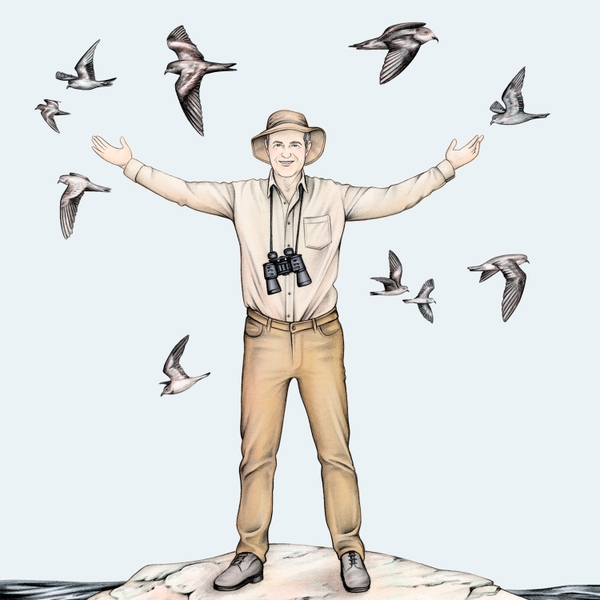What It Takes to See 10,000 Bird Species
Peter Kaestner has traveled the world on an adventure-filled quest to become the first birder to hit 10,000. Ornithologist Jessie Williamson hitched a ride on a rollicking South American mission that involved land, sea, and (you guessed it) air.
New perk: Easily find new routes and hidden gems, upcoming running events, and more near you. Your weekly Local Running Newsletter has everything you need to lace up! .
Editor’s Note: Since this story ran in print (in the May/June 2023 issue of �����ԹϺ���), Kaestner’s life list has increased to 9,856 species, as of May 11, 2023. He is now the world record holder.
The dry valleys outside Lima, Peru, evoke the feeling of being on another planet.
Dust as fine as talcum powder washes the landscape in desolate browns, and bromeliads cling to the west side of rocky slopes, facing the direction that mist blows in from the ocean. Columnar cacti the size of telephone poles resemble hands outstretched toward the sky—puffy, like surgical gloves filled with water.
I was sitting in the middle seat of a battered van snaking up switchbacks to the summit of Tinajas Valley, tires inches from the edge of steep drop-offs. Next to me was Peter Kaestner, one of the world’s most prolific birders. “I can see why I haven’t seen this bird before,” he said, speaking loudly as the van rumbled over dirt and rocks. “It’s not the kind of thing you’re gonna bump into.” Kaestner is tall, with friendly blue eyes, and gives off a smart approachability. (He jokes that when he was younger he resembled Robert Redford, but he knew that he’d hit a turning point in his life when people started comparing him to former Syrian president Hafez al-Assad.)
We were headed to a ridgetop to look for the elusive , a drab brown bird with a curved beak like a T. rex claw. The bird prefers steep-walled desert washes at specific elevations in the central Andes, and would be a “lifer” for Kaestner. Birders call the complete tally of all birds they’ve ever observed their “life list,” and each new species a lifer. A person who keeps track of their life list is a “lister,” and someone obsessed with listing on a global scale is a “big lister.”
I’m a lister myself, though than chasing them. For my PhD at the University of New Mexico, I studied hummingbird migration and speciation in the Andes. These days I work as a postdoc at the Cornell Lab of Ornithology, which runs , the go-to platform for scientists and hobbyists to record bird observations.
On eBird, Kaestner is ranked number one, and he wants to be the first person in the world to see 10,000 bird species. The 69-year-old’s life list is currently at 9,796. The couple hundred birds he still needs are some of the rarest and most difficult in the world to spot. They’re often found in places that are basically inaccessible, off-limits due to political unrest, or threatened by deforestation and climate change. But Kaestner’s quest to hit 10,000 is his personal Dawn Wall, an obsession he’s sustained over decades, and he will not stop until he reaches his goal—if even then.
He’d come to Peru on this 20-day trip in the summer of 2021 to see a handful of the country’s remaining species needed for his life list, and the journey had started out a little rough. During his first night above 15,000 feet, near the Bolivian border just ten days earlier, Kaestner thought he might die of altitude sickness. On an overnight bus to the city of Oxapampa soon after, the driver turned off the air-conditioning over a mountain pass and the cabin became hot and stagnant. COVID risk was high, and Kaestner said the bus felt like a human petri dish. His trip wouldn’t get easier: for one of his top targets, the Ayacucho antpitta, he needed permission to navigate through an unstable area ravaged by Shining Path guerrillas. He expected the middle leg, which I had joined him for, to be relatively tame. “Boring” was the word he used.
As our van slid past another huge vehicle on the singletrack road, tires knocking rocks down the cliffside, I held my breath and wondered about his standard for boredom. Then, as a truck came nose-to-nose with our van, the clutch stopped working. We were on a steep hill.
“There’s too much dust—it must be clogging the transmission,” said Gunnar Engblom, guide and owner of , who had organized our trip. A lanky and who was 60 at the time, Engblom had come to Peru about 25 years earlier to start his bird- and photography-tourism business. He switched from English to frantic Spanish, addressing our driver from the passenger seat.
A look of annoyance appeared on Kaestner’s face. We’d departed late from Lima, then battled incessant traffic, and it was unclear whether Engblom’s run-down van would even make the summit. At best this meant that we would arrive in the hot afternoon, the worst time of day for bird activity, before driving another eight hours to our next destination. Engblom’s reputation as “Captain Chaos” was well-known in the bird world (one client described him as the “Crocodile Dundee of South America”) and Kaestner knew what he was getting into. Still, even for Kaestner, a former U.S. diplomat who built a career managing high-stakes logistics, the situation was trying. After all he’d invested, he didn’t want to miss his target—or “dip,” as birders say.





